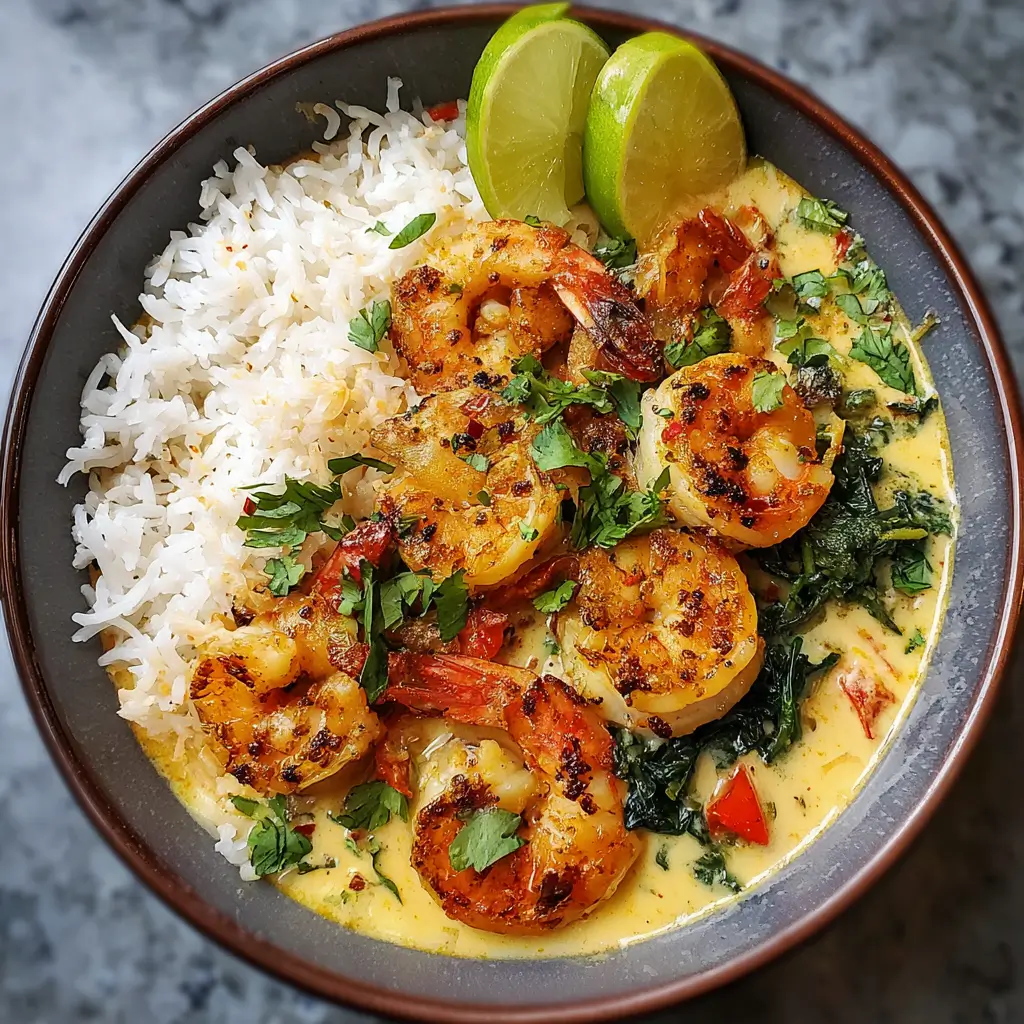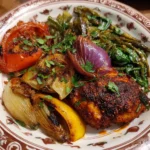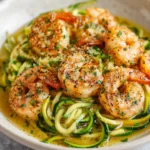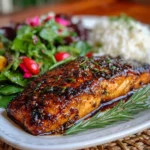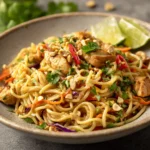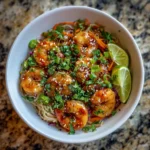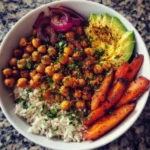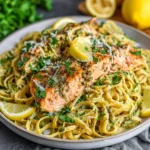Thai Coconut Curry Shrimp: A Flavorful Journey Through Southeast Asia
Indulge in the aromatic, creamy, and slightly spicy delight of Thai Coconut Curry Shrimp—a dish that captures the essence of Thailand’s vibrant culinary traditions. With its rich coconut milk base, tender shrimp, fragrant herbs, and bold spices, this curry is a harmonious blend of sweet, savory, tangy, and spicy flavors. Whether you’re cooking for a weeknight dinner or impressing guests at a weekend gathering, this recipe delivers restaurant-quality taste with ease. In this comprehensive guide, we’ll explore every aspect of this beloved dish—from its historical roots to ingredient breakdowns, step-by-step instructions, expert tips, variations, health benefits, and frequently asked questions—so you can master the art of making authentic Thai Coconut Curry Shrimp right in your own kitchen.
The History of Thai Coconut Curry Shrimp
Thai cuisine is renowned for its balance of five fundamental tastes: sweet, sour, salty, bitter, and spicy. Curries are central to Thai food culture, and among them, coconut-based curries hold a special place. The use of coconut milk in Thai cooking dates back centuries, particularly in southern Thailand where coconuts grow abundantly. Southern Thai curries often feature rich, creamy textures derived from fresh coconut milk, distinguishing them from the drier, chili-paste-heavy curries of northern regions.
Shrimp, a staple seafood in coastal areas of Thailand, naturally found its way into many regional dishes. Over time, the combination of succulent shrimp simmered in a spiced coconut broth evolved into what we now know as Thai Coconut Curry Shrimp. Influences from Indian, Chinese, and Malay cuisines also contributed to the development of Thai curries—particularly through the introduction of curry pastes, which form the flavor foundation of most Thai curries.
Today, Thai Coconut Curry Shrimp (often based on red, green, or yellow curry) has gained international acclaim. It’s not only a favorite in Thai restaurants worldwide but also a popular choice for home cooks seeking an exotic yet approachable meal. While modern versions may vary, traditional preparation emphasizes fresh ingredients, balanced seasoning, and slow-simmered depth of flavor.
Ingredients Breakdown: What Makes This Dish Shine?
The magic of Thai Coconut Curry Shrimp lies in the synergy between its components. Each ingredient plays a crucial role in building layers of aroma, texture, and taste. Here’s a detailed look at the key elements:
- Shrimp: Fresh or high-quality frozen medium to large shrimp (peeled and deveined) are ideal. They cook quickly and absorb the curry’s flavors beautifully.
- Coconut Milk: Full-fat canned coconut milk provides a luscious, creamy base. It balances the heat and acidity while adding subtle sweetness.
- Curry Paste: Store-bought or homemade red, green, or Massaman curry paste contains a blend of chilies, lemongrass, galangal, garlic, shallots, and spices. Red curry paste offers moderate heat; green is spicier; yellow is milder and more aromatic.
- Fresh Aromatics: Lemongrass (bruised), kaffir lime leaves, and galangal (or ginger substitute) infuse the curry with authentic Thai fragrance.
- Fish Sauce: A fermented condiment made from fish and salt, it adds umami depth and saltiness without overpowering the dish.
- Palm Sugar or Brown Sugar: Used to round out the flavors, balancing the spice and acidity.
- Lime Juice: Freshly squeezed lime juice adds brightness and cuts through the richness at the end.
- Vegetables: Common additions include bell peppers, bamboo shoots, eggplant, or baby corn for texture and color.
- Basil: Thai holy basil or sweet basil is stirred in at the end for herbal freshness.
- Garnishes: Sliced red chilies, cilantro, lime wedges, and toasted coconut flakes elevate both presentation and flavor.
Step-by-Step Recipe: How to Make Thai Coconut Curry Shrimp
Follow these detailed steps to create a perfectly balanced Thai Coconut Curry Shrimp that bursts with flavor and elegance.
- Prepare Ingredients: Peel and devein the shrimp, pat dry, and set aside. Chop vegetables into bite-sized pieces. Measure out coconut milk, curry paste, fish sauce, sugar, and lime juice. Bruise lemongrass by smashing it lightly with the side of a knife. Tear kaffir lime leaves slightly to release oils.
- Sauté the Curry Paste: Heat 1 tablespoon of neutral oil (like vegetable or coconut oil) in a large skillet or wok over medium heat. Add 2–3 tablespoons of Thai red or green curry paste (adjust to taste). Stir constantly for 1–2 minutes until the paste darkens slightly and becomes highly aromatic—this “blooms” the spices and intensifies flavor.
- Add Coconut Milk: Pour in 1 can (about 400 ml) of full-fat coconut milk. Whisk well to combine with the curry paste. Let the mixture come to a gentle simmer, allowing the oils to separate slightly and the flavors to meld. Skim off any foam if necessary.
- Infuse Aromatics: Add the bruised lemongrass stalk, 2–3 torn kaffir lime leaves, and a few slices of galangal (or ginger). Simmer for 5 minutes to infuse the broth with fragrance.
- Incorporate Vegetables: Add chopped bell peppers, sliced bamboo shoots, or other firm vegetables. Cook for 5–7 minutes until just tender but still crisp.
- Season the Broth: Stir in 1–2 tablespoons of fish sauce, 1 teaspoon of palm sugar (or brown sugar), and a splash of soy sauce (optional for depth). Taste and adjust—add more sugar for sweetness, fish sauce for saltiness, or lime juice later for acidity.
- Cook the Shrimp: Add the shrimp to the simmering curry. Cook for 3–5 minutes, stirring occasionally, until the shrimp turn pink and opaque. Avoid overcooking, as shrimp become rubbery when boiled too long.
- Finish with Freshness: Remove the lemongrass, lime leaves, and galangal. Stir in the juice of half a lime and a generous handful of torn Thai basil leaves. The acid brightens the dish, while the basil adds a peppery, anise-like note.
- Garnish and Serve: Ladle the curry into bowls. Top with sliced red chilies, fresh cilantro, extra basil, and a lime wedge. For added crunch, sprinkle with toasted coconut flakes or fried shallots.
Tips for Perfect Thai Coconut Curry Shrimp Every Time
- Bloom the Curry Paste: Never skip sautéing the curry paste in oil—it unlocks essential oils and deepens flavor dramatically.
- Use Full-Fat Coconut Milk: Light coconut milk will result in a watery, less flavorful curry. Shake the can well before opening, or stir thoroughly if using a carton.
- Don’t Boil Too Hard: Keep the heat at a gentle simmer after adding coconut milk to prevent curdling or separation.
- Control Spice Level: Start with less curry paste and add more gradually. You can always increase heat, but you can’t take it away.
- Add Acid Last: Lime juice should be added at the end to preserve its vibrant, zesty character.
- Prevent Overcooked Shrimp: If serving later, undercook shrimp slightly and finish heating just before serving.
- Make Ahead Friendly: The curry base (without shrimp and herbs) can be made 1–2 days in advance. Reheat gently and add shrimp and fresh ingredients when ready to serve.
- Balance Flavors: Always taste before serving. Aim for harmony: a little sweet, salty, sour, and spicy in each bite.
Variations and Customizations
One of the joys of Thai Coconut Curry Shrimp is its versatility. Feel free to adapt it to your preferences or dietary needs:
- Protein Swaps: Replace shrimp with chicken, scallops, tofu, or even thinly sliced beef. Adjust cooking times accordingly.
- Vegetarian/Vegan Version: Omit shrimp and use mushrooms, chickpeas, or paneer. Substitute fish sauce with soy sauce or tamari (for gluten-free), and ensure curry paste is vegan-friendly.
- Different Curry Pastes: Try green curry for more heat, Massaman for nuttiness, or Panang for a thicker, peanut-infused profile.
- Add Nuts: Stir in crushed roasted peanuts or cashews for texture and richness.
- Noodle Integration: Turn it into a curry noodle bowl by serving over rice noodles, udon, or vermicelli.
- Rice Pairings: Classic jasmine rice is traditional, but try sticky rice, coconut rice, or cauliflower rice for low-carb options.
- Extra Veggies: Zucchini, broccoli, spinach, snow peas, or bok choy can be added depending on seasonality.
- Spice Boost: Add sliced bird’s eye chilies or a dash of chili oil for extra fire.
- Herb Variations: Mint or cilantro can complement or replace basil for a different aromatic twist.
Health Considerations and Nutritional Value
Thai Coconut Curry Shrimp isn’t just delicious—it can be part of a nutritious diet when prepared mindfully.
- Shrimp: Low in calories and fat, high in protein, selenium, iodine, and omega-3 fatty acids. Supports heart and brain health.
- Coconut Milk: Contains medium-chain triglycerides (MCTs) that may boost metabolism. However, it’s calorie-dense and high in saturated fat—moderation is key. Opt for BPA-free cans when possible.
- Vegetables: Add fiber, vitamins (A, C, K), and antioxidants. Colorful bell peppers and leafy greens enhance nutrient density.
- Herbs and Spices: Lemongrass and galangal have anti-inflammatory and digestive properties. Chilies contain capsaicin, which may aid metabolism.
- Fish Sauce: High in sodium, so use sparingly if you’re monitoring salt intake. Look for reduced-sodium versions or substitute with coconut aminos.
- Sugar Content: Palm sugar is natural but still a sugar. Use minimal amounts, or try monk fruit or stevia for a sugar-free option.
Nutritional Estimate (per serving, approx. 1.5 cups with shrimp and vegetables):
Calories: 320–400 | Protein: 20–25g | Fat: 22–28g (mostly from coconut) | Carbohydrates: 12–16g | Fiber: 3–5g | Sodium: 600–900mg (varies with fish sauce)
Note: Values depend on specific ingredients and portion sizes. For lower fat, use light coconut milk and reduce quantity. For lower carbs, limit added sugars and starchy veggies.
Ingredients
- 1 lb (450g) large shrimp, peeled and deveined
- 1 can (400ml) full-fat coconut milk
- 2–3 tbsp Thai red or green curry paste (adjust to taste)
- 1 stalk lemongrass, bottom third bruised and cut into 2-inch pieces
- 3–4 kaffir lime leaves, torn
- 1-inch piece galangal (or ginger), sliced (optional)
- 1 red bell pepper, sliced
- ½ cup bamboo shoots (canned or fresh)
- 1–2 tbsp fish sauce (to taste)
- 1 tsp palm sugar or brown sugar
- Juice of ½ lime
- ½ cup fresh Thai basil or sweet basil leaves
- 1 tbsp neutral oil (coconut, vegetable, or avocado)
- Optional garnishes: sliced red chili, cilantro, lime wedges, toasted coconut, fried shallots
Directions
- Heat oil in a large skillet or pot over medium heat. Add curry paste and sauté for 1–2 minutes until fragrant.
- Pour in coconut milk, whisking to combine. Bring to a gentle simmer.
- Add lemongrass, kaffir lime leaves, and galangal. Simmer for 5 minutes to infuse flavors.
- Stir in bell pepper and bamboo shoots. Cook for 5–7 minutes until vegetables soften slightly.
- Season with fish sauce and palm sugar. Taste and adjust seasoning.
- Add shrimp and cook for 3–5 minutes until pink and cooked through.
- Remove aromatics (lemongrass, lime leaves, galangal). Stir in lime juice and basil.
- Serve hot over jasmine rice, garnished as desired.
FAQ
Can I use frozen shrimp?
Yes, frozen shrimp work well—just thaw them in cold water and pat dry before cooking to avoid excess moisture.
Is Thai Coconut Curry Shrimp gluten-free?
Typically yes, but check labels on curry paste and fish sauce, as some brands may contain wheat. Use tamari instead of soy sauce if needed.
How do I store leftovers?
Cool completely and refrigerate in an airtight container for up to 3 days. Reheat gently on the stove—avoid microwaving at high power to prevent curdling.
Can I freeze this curry?
Yes, though the texture of coconut milk may separate slightly upon thawing. Stir well while reheating, and consider adding fresh lime and herbs after warming.
What’s the difference between red and green curry paste?
Red uses dried red chilies (moderate heat, earthy); green uses fresh green chilies (spicier, brighter). Green tends to be hotter, but heat varies by brand.
Can I make it without fish sauce?
Yes—use soy sauce, tamari, or coconut aminos for saltiness. For umami depth, add a pinch of mushroom powder or miso.
Why did my coconut milk curdle?
High heat or acidic ingredients added too early can cause separation. Always simmer gently and add lime juice at the end.
Is this curry keto-friendly?
With minor tweaks—skip sugar, limit higher-carb vegetables, and serve over cauliflower rice—it can fit into a ketogenic diet.
Summary
Thai Coconut Curry Shrimp is a luxurious yet simple dish that brings the vibrant flavors of Thailand into your kitchen—creamy coconut milk, aromatic spices, plump shrimp, and fresh herbs unite in perfect harmony. Quick to prepare and endlessly customizable, it’s a satisfying meal that delights the senses and nourishes the body.
